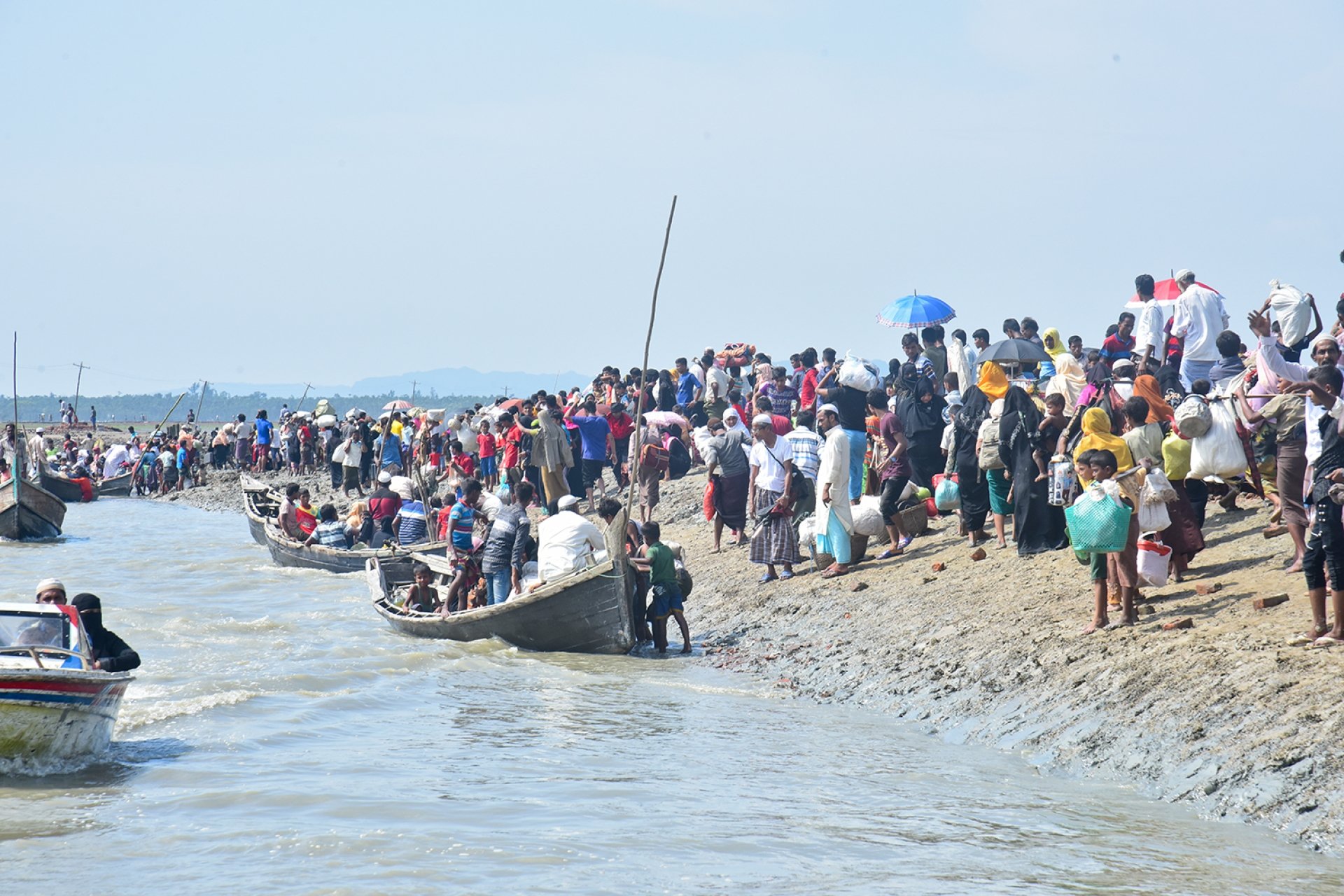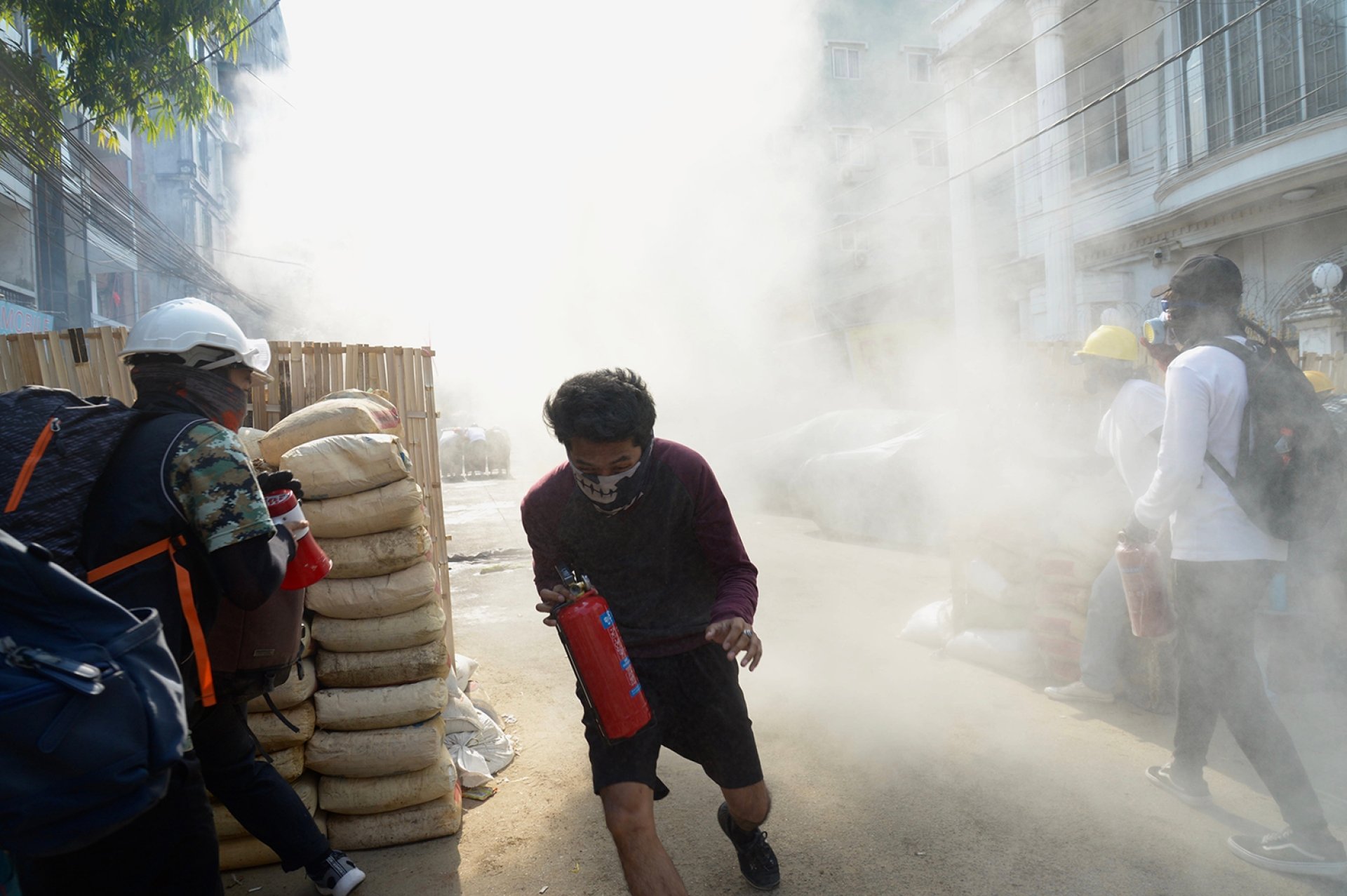Since achieving independence from Britain in 1948, Myanmar has experienced the world’s longest running civil war. Despite its exhortations as to being the country’s stabilizer, Myanmar’s military, known as the Sit-Tat, has only exacerbated the conflict and turned the country into a source of instability across its decades of rule. It once again plunged Myanmar into chaos with its February 2021 coup, abruptly wrenching the country from its revitalized path towards stability and prosperity to that of a failed state.
As long as the Sit-Tat remains in power, Myanmar will be mired in violence and edging towards total collapse. Unseen since the 1960s, the renewed intensity of Myanmar’s internal violence promises to spill over into neighboring countries and undermine a relatively stable region. Refugee crises and other humanitarian disasters, the spillover of violence, drug trafficking, and a revisionist stance towards international order are all substantially likelier now than before 2021. At a regional level, junta-ruled Myanmar, which sits at the crux of China, South Asia, and Southeast Asia, poses a distinct challenge to regional order, particularly as a spoiler within ASEAN and a revisionist state willing to issue a full-throated endorsement of Russia’s invasion of Ukraine and Beijing’s threats against Taiwan.
Instead of buttressing the faltering junta, Myanmar’s neighbors should instead understand the Sit-Tat’s role as Myanmar’s source of instability both in the past and, to an unprecedented extent, going forward. An unrestrained junta will only spur the further breakdown of stability in Myanmar, lead to spillover throughout the region, and contribute to the destabilization of international order. Addressing Myanmar’s instability means recognizing the junta for what it is and taking greater steps to expand support for the pro-democracy movement to end military rule.
Myanmar’s Sit-Tat as a Local and Regional Destabilizer
Myanmar has always teetered on the edge of instability due to the Sit-Tat’s misrule. Indeed, its lack of control and manipulation of the long-running war to protect its political leadership has only exacerbated Myanmar’s internal conflicts. In previous eras, the Sit-Tat isolated itself and the country it ruled on the international stage, keeping its violence and oppression contained largely to Myanmar’s periphery.
Yet, even then, Myanmar’s instability had ripple effects. Chronic instability has helped turn the so-called “Golden Triangle” into one of the world’s leading producers of narcotics. Its periodic attempts to crush Myanmar’s diverse array of ethnic armed groups have caused large spikes in violence, some of which crosses borders. In 2015, fighting in the Kokang region led to the military’s accidental bombing of Chinese territory, the death of several civilians, and refugees fleeing into Yunnan Province. The Sit-Tat next instigated the 2017 Rohingya genocide and refugee crisis that led to over 900,000 fleeing into Bangladesh. Demonstrating the concern the international community felt for the regime, U.S. Secretary of State Hillary Clinton even expressed concerns in 2009 about potential North Korean nuclear assistance to the Sit-Tat.
The post-2021 coup environment radically escalates the instability and threatens to plunge the country into failed state status, which only amplifies the risks further in a terrible feedback loop. Whereas the Sit-Tat’s culture of violence and the on-and-off again civil war previously ignored the Bamar majority, the 2021 crackdown on protesters and indiscriminate violence triggered a widespread popular resistance across all of Myanmar’s ethnic groups. This spiraled into a full-scale civil war that touches 266 out of 330 townships. The war’s unprecedented scale and the unwillingness of either side to negotiate portends a protracted conflict that could last years and trigger greater displacement.
The military’s mismanagement, the continued commitment of the Civil Disobedience Movement, and the flight of international businesses contribute further to the devastation. The economy and government services apparatus now teeter on the edge of collapse as a result of the coup. The World Bank estimated that 40 percent of Myanmar’s population is now impoverished, a doubling in its poverty rate that essentially reverses the gains made under democratization. This assessment also reported that GDP is about 13 percent less than in 2019, and the odds that international investors, scared off by the junta’s willingness to intervene in the economy and Western sanctions, re-enter Myanmar are low.
With the multifaceted post-coup crisis and destabilizing actors in power, Myanmar is increasingly a black hole of instability and chaos with impacts that extend beyond its borders. Previous eras of military rule triggered instability and spillover, but the growing scale of this iteration renders the situation of far more concern for Myanmar’s neighbors than in previous decades.

The Risk of Spillover into South and Southeast Asia
Much as how the civil wars in Afghanistan, Iraq, Somalia, and Syria destabilized the surrounding region through spillover effects, a fragmenting and collapsing Myanmar threatens to do the same for South and Southeast Asia. From the direct impact of cross-border violence to second order effects, such as refugee crises and drug trafficking, a weak state beset by conflict at the juncture of South and Southeast Asia could prove to be a long-term problem for the geo-strategically vital, and tense, Indo-Pacific.
Although previous eras of military rule saw Myanmar isolated and disconnected from its neighbors, the growing ambitions of great powers to spread their influence mean the junta’s actions have more impact on regional politics. Geographically, Myanmar sits astride South and Southeast Asia, and both India and China view the country as a gateway and target for substantial investment, as do Japan, Singapore, Thailand, and others. New Delhi’s Act East Policy hopes to connect India and its Northeast to ASEAN via Myanmar, while China’s Belt and Road Initiative aims to bypass the “Malacca Dilemma” by opening up an energy and infrastructure route to the Indian Ocean. Although both governments have warmed up to the junta in a bid to maintain their influence—lest their competitor gain an edge—continued instability and fighting within Myanmar will only stymie the country’s development and its former promise as an economic juncture between China, South Asia, and Southeast Asia.
In early July of this year, the news that two Indian citizens were allegedly killed by pro-junta militia in Myanmar stirred up anger amongst local residents in the Indian border town of Moreh. The February 1st military coup brought to the fore long-running instability along the border with India, which could impact New Delhi’s own simmering conflicts with its Northeastern insurgencies that operate in the liminal border zone. To the east, a Myanmar military fighter jet crossed into Thai airspace on a bombing run against anti-junta forces in July 2022. This airspace violation forced local authorities to evacuate villages and schools in this area, and, despite the Thai government downplaying the incident per their close ties to the junta’s generals, raised concerns about security amongst Thai people living adjacent to Myanmar. According to Thailand’s government, incursions by Myanmar forces into its territory occurred four or five times this past year.
To the north, China, which has historically played a complicated dual game of backing ethnic armed groups, maintaining ties to the opposition, and working with the junta, is also troubled by border spillover. Last year, the Sit-Tat's stray artillery shells frequently landed on Chinese territory along the border, causing damage to private property. This reportedly spurred a stern warning from Beijing to avoid the border and to better protect Chinese assets in Myanmar, such as the multibillion strategic infrastructure route, the China-Myanmar Economic Corridor, which has been targeted by some anti-junta forces.
The fighting along periphery areas, particularly the Myanmar military’s brutal “Four Cuts” scorched earth counter-insurgency campaigns also spur a brewing refugee crisis. In July 2022, the UN estimated that almost 770,000 people have now been internally displaced and over 41,000 are refugees, largely to Thailand and India. China too is not spared by the refugee crisis, as intermittent conflicts along Myanmar’s north-east border have often led people to seek refuge in Yunnan Province. In response, the Chinese authorities are erecting a 600 kilometer barbed-wire fence along its border with Myanmar.
Beyond refugees, a striking surge in drug production and trafficking accompanies the coup. Myanmar is traditionally central to the drug trade in Southeast Asia and is one of the largest producers of synthetic drugs in the world. Several non-state actors, including a few ethnic armed groups, such as the United Wa State Army, took advantage of the security vacuum and the collapse of the formal economy to increase production and smuggling. According to figures compiled by the UN Office on Drugs and Crimes (UNODC), seizures of methamphetamine from January through October of 2021 were “up 20 percent in Thailand compared to 2020, up 40 percent in Malaysia,” and a shocking 620 percent in Laos. UNODC reported in May 2022 that over one billion methamphetamine tablets were seized in East and Southeast Asia in 2021.

Myanmar’s Junta as a Revisionist Rogue State
The junta looks for friends where it can in a hostile international environment, such as its authoritarian neighbors, China and Thailand, but Min Aung Hlaing’s State Administration Council (SAC) appears to most privilege ties to revisionist states further afield. Reports suggest covert flights from sanctioned Iranian planes landed in Naypyidaw, while others claim that the Sit-Tat’s ties to North Korea have restarted around ballistic missile development. Likely still harboring nuclear desires of some kind, coup leader Min Aung Hlaing visited Russia in July 2022 to ink a memorandum with Rosatom, a state-owned nuclear energy firm, for expanded atomic energy cooperation.
China, meanwhile, has a long and complicated history with Myanmar, and Beijing pragmatically backs the junta. Reflective of its longstanding aim in Myanmar of maintaining ties to the powers that be, China quickly downplayed the 2021 February coup as a “cabinet reshuffle,” and its ensuing crisis as an “internal affair.” Chinese Foreign Minister Wang Yi once said in a meeting with his junta counterpart that, “no matter how the situation changes, China will support Myanmar in safeguarding its sovereignty, independence and territorial integrity, and in exploring a development path suited to its national conditions.” In return, the Sit-Tat’s statement endorsed China’s position during U.S. House Speaker Nancy Pelosi’s visit to Taiwan.
Yet, the China-Sit-Tat relationship is more complex under the surface, and many in the ruling junta distrust Beijing for its past ties to Aung San Suu Kyi’s ousted National League for Democracy and covert support for ethnic armed groups along the border. Thus, the junta keeps Beijing at arm’s length out of fear that China's “no matter how the situation changes”-level of support may be less ironclad than it seems. Moreover, while Beijing certainly demonstrates revisionist preferences, notably towards U.S. security architecture, alliances, and liberal values, China also desires stability. Beijing wants to avoid disorder not of its choosing so that the aspects of international order that benefit it—economic integration, trade, and interconnectivity—can function unhindered.
In an attempt to offset dependence on China, Russia remains the only country that Min Aung Hlaing has personally visited, twice, since the military takeover. Even if the junta caters to the most revisionist impulses in Beijing’s behavior towards regional order, it does not mean that it prefers Beijing to Moscow. China may provide a larger share of arms to Myanmar’s military and billions in investments, but it is Russia who is clearly the partner of choice for Min Aung Hlaing. Myanmar-Russia relations should therefore be viewed as distinct from its ties to the Chinese.
Russia-junta partnership is best seen in the junta’s full-throated support for Moscow’s invasion of Ukraine. In an interview with Voice of America, a junta spokesperson said that “Russia has worked to consolidate its sovereignty. I think this is the right thing to do.” This stands in stark contrast to its domestic opponent, the pro-democracy National Unity Government—who control Myanmar’s UN seat—and its fellow ASEAN member states. Cambodia, an authoritarian country, even chose to co-sponsor the UN resolution condemning Russia, while Moscow’s close partner Vietnam chose to abstain rather than vote “no” in support of Putin’s war.
It stands to reason that the ruling junta, beholden to revisionist actors and radicalized by an existential civil war and Western sanctions, will feel inclined to support policies that undermine international order for its own short-sighted gains. This is distinct from the earlier Than Shwe regime’s isolation. Perhaps a reflection of rising multipolarity and great power competition, as well as the Sit-Tat’s own extremism, the junta embraces revisionist stances towards international order. This poses a serious threat to the region, particularly ASEAN.
For ASEAN, an openly revisionist junta stands as a poison pill within a struggling regional bloc desperate to assert Southeast Asian interests in a multipolar, competitive environment. Indeed, as a general rule of thumb, ASEAN member states opt to maintain balanced, non-aligned foreign policies to avoid alienating any great powers. This has worked to their benefit, and even those that are more aligned one way or the other, such as Cambodia with Beijing and Singapore and Vietnam with Washington, still look to keep channels open and bypass taking a side in great power competition.
The new Myanmar junta, on the other hand, violates this practice with its embrace of rogue regimes, contempt for international norms such as territorial sovereignty—of vital importance for Southeast Asian countries—and willingness to do whatever it takes to maintain support from revisionist states. If fully returned to good standing within ASEAN, it will likely serve as a spoiler and advocate for Russian and Chinese interests. For a grouping that hopes to present a united front as the “central” forum in Southeast Asia, this could be the blow that renders ASEAN increasingly irrelevant just at a time when China, the United States, and others jostle for greater influence in the region.

False Hopes of Junta Victory and Moderation
Despite the junta’s instability and revisionist behavior, regional states, such as India, Thailand, and other more authoritarian ASEAN members, as well as the still cautious Australia and Japan, are less willing than the United States and the European Union to impose sanctions or promote democracy and are more open to maintaining some ties to the military. Indeed, it is conventional wisdom in some capitals that the Sit-Tat, as a strong institution, will ultimately prevail by force over its opposition in an internal tug-of-war. Therefore, these countries always strive to maintain relations with the military, even if it faces a popular resistance. Moreover, many anticipate that the junta will moderate its behavior once its hold is secure, and Myanmar will return to a previous normalcy, much like how Thailand regained international legitimacy following its coup in 2014.
This belief extends to Beijing, whose policy rests on the same pragmatic calculations rather than any inherent affinity for the junta. This is best seen in Chinese Foreign Minister Wang Yi’s July visit to Myanmar for a Lancang-Mekong Cooperation meeting where he declined a personal meeting with Min Aung Hlaing. China supports the junta out of a belief in the Sit-Tat’s narrative that the military alone can stabilize Myanmar, not any deep-set loyalty. For now, China assesses that a pro-democracy victory is not likely and a junta collapse would mean a failed state along its border.
The hedged assessment, whether made in Beijing or in other regional capitals, that the junta will somehow moderate itself and regain control is incorrect. For one, it is unlikely that Western sanctions will be rolled back enough even in the event of a junta victory to prevent its pariah status or moderate its revisionist behavior. Secondly, and more importantly, it is increasingly apparent that a military government in Naypyidaw cannot regain control over the country.
Despite its pledge to hold elections in August 2023, the SAC is unlikely to allow a return to democracy, and its brutal violence towards civilians and rejection of any other authority but its own have stirred up the vast majority of Myanmar’s people to openly and vigorously reject its rule. More to the point, it has never once controlled the whole of Myanmar. It will remain a source of instability and spillover for the foreseeable future, and its willingness to embrace revisionism towards international order renders it a source of regional concern, including for China given the junta’s obvious preference for Russia and distrust of Beijing.
Policymakers throughout the region and beyond should therefore understand that the stumbling block to stability in Myanmar is the military itself. The threat to Chinese interests in Myanmar is neither Western influence nor the general public but the military as the country’s main source of instability. It would therefore benefit Beijing’s interests to more openly engage the National Unity Government, facilitate efforts to restrain the junta, and lessen its international support for the generals. ASEAN meanwhile must overcome its reluctance to violate its norms of non-interference and consensus to address the far greater risk that a chaotic junta poses to its viability as an institution. The junta will simply continue to ignore ASEAN’s concerns and desires, as strikingly demonstrated with the July 2022 execution of four democracy activists against the direct wishes of ASEAN Chair and Cambodian Prime Minister Hun Sen. Others beyond the region, including Australia, Japan, and India, should recognize that holding the door open for the junta, even a bit, is not the pragmatic policy it appears to be but rather a serious risk to regional stability and their interests. Even those in the West that are more willing to impose serious costs on the military, including the United States and EU, can do more to back up the pro-democracy movement in Myanmar.
Myanmar is in the midst of an incredibly complex, long-running civil war that appears intractable at times. There is also no guarantee that the pro-democracy movement, and the National Unity Government that claims to lead it, can overcome the Sit-Tat militarily or unify the country. Nor is it certain that their promises to address Aung San Suu Kyi’s shortcomings during the previous era of democratization by forging a democratic federal union that brings together all Myanmar’s people will come to pass.
But, it is certain that the junta, whether its brutal repression succeeds in putting the lid temporarily on Myanmar’s boiling revolution or becomes a failed state, poses grave risks to regional stability, both through the spillover effects of the conflict and the revisionism of its dictator. Countering the military takeover should thus be a priority for Myanmar’s neighbors lest the situation spiral further out of control.
The views expressed are the authors’ alone, and do not represent the views of the U.S. Government or the Wilson Center.
Authors

Visiting Scholar, US Institute of Peace; Former Executive Director, Tagaung Institute of Political Studies


Indo-Pacific Program
The Indo-Pacific Program promotes policy debate and intellectual discussions on US interests in the Asia-Pacific as well as political, economic, security, and social issues relating to the world’s most populous and economically dynamic region. Read more

Explore More
Browse Insights & Analysis
Greenland’s New Governing Coalition Signals Consensus

Myanmar’s Junta and the 2026 Elections: A Fig Leaf for Legitimacy?




